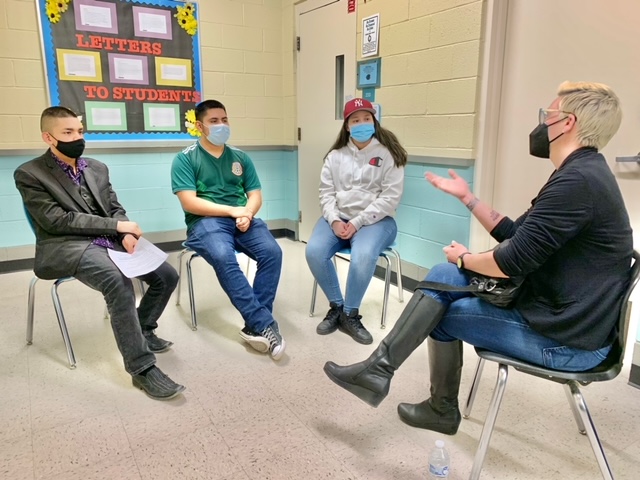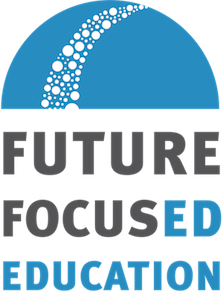How the Power of Peer Support Can Transport Internships

A one-on-one internship with an adult can be intimidating. Especially for a shy high schooler.
“These kids don’t have conversations with adults that often,” Brian Brown says. “So how are they supposed to know how to compose a professional email without emojis? That’s all they know.”
Brown is the former Director of Central New Mexico Boys and Girls Club. He partnered with Future Focused’s X3 program to create a group internship at Highland High School, located in Albuquerque's International District. The internship focuses on workforce skill building.
The International District is a community full of assets that is undeveloped because of chronic disinvestment, institutional oppression and a general lack of care and concern for its inhabitants. This project aims to reimagine the young people who live there as the critical component of the health and prosperity of their community.
“This internship was created for students who have no experience in the workplace at all,” says Jaime Hernandez, Future Focused X3 coach and internship facilitator. “The experience prepares them to go into job sites, and understand the dynamics of workplace culture.”
Skills like confident eye contact or how to follow up after an interview are critical, but are often not taught in schools. Brown says he has a straight-A student who admitted she never knew how to write an email until this internship showed her how.
These types of professionalism skills need to be taught in an interactive, engaging way, he says, otherwise the kids aren’t motivated to listen or integrate them.
Brown describes the internship environment as a “safe space where the kids are allowed to think about things and express what comes up. They’re not being talked at.”
“I’m very mindful to tell the students that ‘I'm not a teacher, I'm a coach’. I’m not going to grade their work or judge them,” says Hernandez, “I’m there to hear their questions, listen to their needs, and give them tools to succeed in whatever career path you're looking to explore.”
Why Group Internships?
The power of a group internship is peer support. The group dynamic offers a less intimidating option than a one-on-one internship with a professional.
Students in the Highland group have common ground as peers from the same high school—even if they come from different backgrounds or even speak different languages. In fact, the Highland internship is fully bilingual.
“I relate to Spanish speaking students because I was a student like them,” Hernandez explains. “They are talented and smart, their only barrier is that they came from another country, they are pursuing a better life.”
The students find comfort and support among their peers, and feel encouraged to speak up. Hernendez conducts the internship in both English and Spanish, so students can ask him or each other how to express something if they’re otherwise too nervous or shy.
“Many students tell me they didn’t know each other at all before this internship,” Hernandez says. “It’s amazing to see young people with language barriers and different backgrounds come together, help each other, and become friends.”
Setting Expectations for Success
The group internship begins with an essential exercise: expectation setting. Consensus and accountability form the foundation of the group dynamic. As a team the students determine baseline expectations for how the group will operate.
For example, the last cohort set expectations such as “be on time,” “respect others’ opinions,” “be attentive,” and “communicate with professionalism”.
Then, if later in the semester, a student isn’t showing up or being respectful, the group can call them on it. Hernandez says the students really show up differently when they have accountability among each other.
Next, the group works on goal setting, and exploring their passions, and how to turn that into a career.
“We have a future focus,” says Brown. “We make sure the internship is outcome driven. Our goal is to reach the ones that need us most, those who may not see the opportunities they have.”
Through tours to local businesses and interview sessions with local professionals, the students get to explore the opportunity space and build their professional skills early.
Instead of prescribing a curriculum, Hernandez says, “we bring in professionals to speak with them, and the students drive the conversations, asking the questions they want to know.”
Instead of lectures where the teacher talks most of the time, “the internship is designed to be student-centered and student-driven so that students’ voices are heard,” Hernandez says.

A Big Pay Off
A major difference between the X3 program and other internships is that the X3 interns are paid.
“Highland kids experience a lot of insecurity,” Brown says. The high school is located in a district with high poverty and crime. “When the students can bring home a check, talk competently about finances, and become a provider in their family, that takes a burden off.”
After the internship, the students can continue in the X3 program to get an individual internship and continue their professional growth.
“These kids are not always looking at their future, they have a lot of other things to deal with, so raising their awareness of opportunities earlier is essential,” says Brown.
X3 internships help build their money and time management skills—along with growing their professional network—meaning they get employed in meaningful career-focused work earlier in life, rather than working fast food or minimum-wage jobs.
“When we help these kids become more productive teenagers, who are helping out at home and in their communities,” Brown says, “there’s a ripple effect where more kids are in positive situations.”

